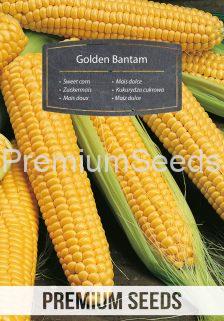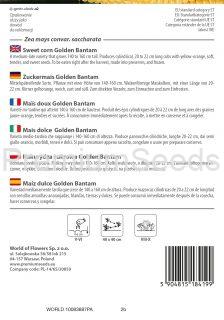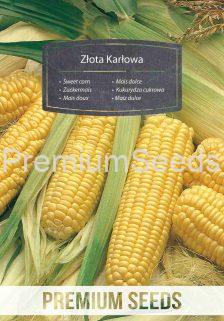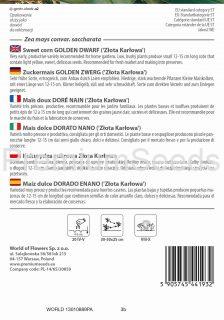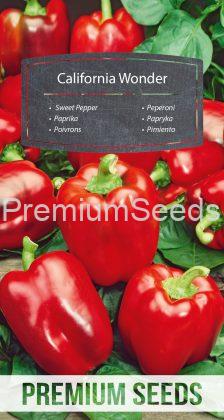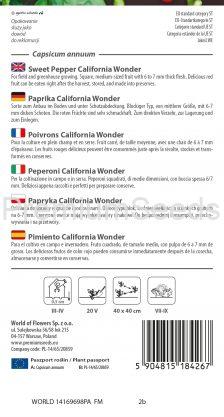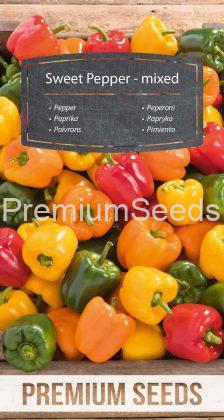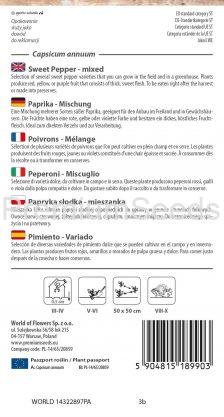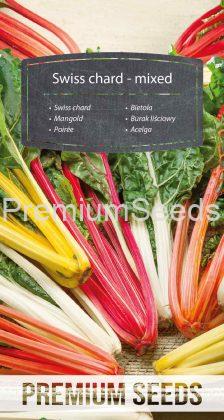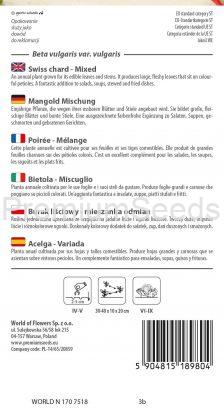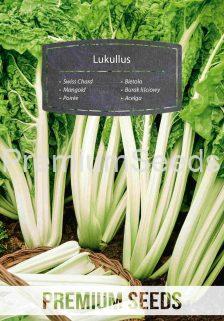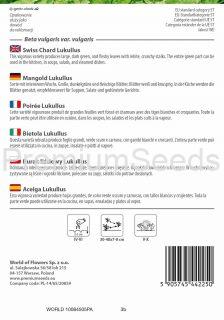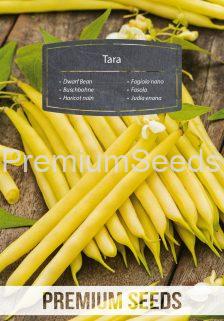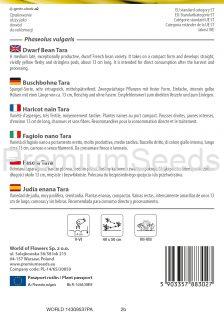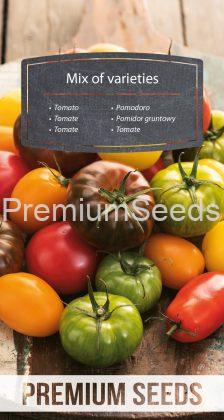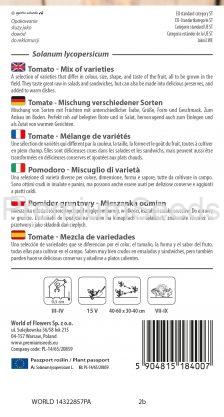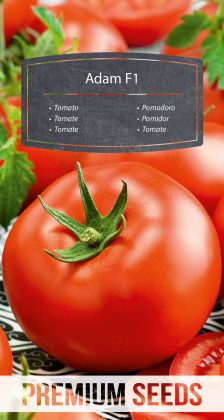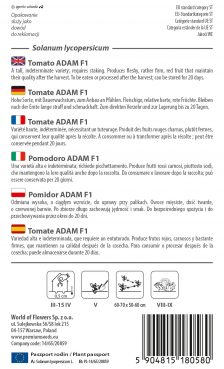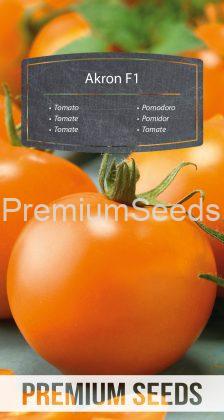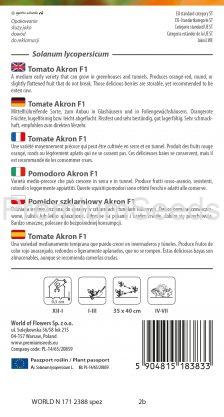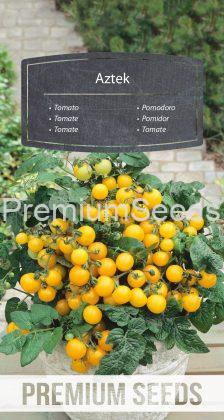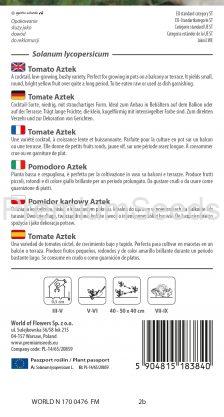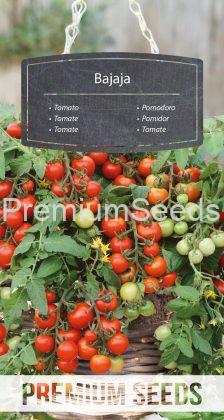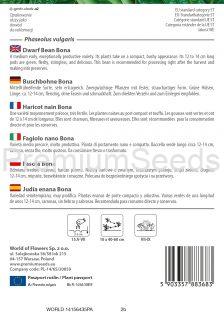Vegetable Seeds
Showing 217–228 of 271 results
-
Sweet corn – Golden Bantam
A medium-late variety that grows 140 to 160 cm tall. Produces cylindrical, 20 to 22 cm long cobs with yellow-orange, soft, tender, and sweet seeds. To be eaten right after the harvest, made into preserves, and frozen.
Sweet corn – Golden Bantam – seeds
Seeding depth: 4 – 6 cm
Seeding time outdoors: May – June
Spacing: 30-40 x 5-8 cm
Harvesting period: July – October
One package contains 20 g of seeds. -
Sweet corn GOLDEN DWARF (‘Złota Karłowa’)
Very early, productive variety recommended for home gardens. Low, bushy plants produce small 12-15 cm long cobs that contain light yellow, sweet, delicious seeds. Recommended for fresh market and making into preserves.
Sweet corn GOLDEN DWARF (‘Złota Karłowa’) – seeds
Seeding depth: 4 – 5 cm
Seeding time outdoors: 20 April – May
Spacing: 30-50 x 25 cm
Harvesting period: September – October
One package contains 20 g of seeds. -
Sweet Pepper – California Wonder
For field and greenhouse growing. Square, medium-sized fruit with 6 to 7 mm thick flesh. Delicious red fruit can be eaten right after the harvest, stored, and made into preserves.
Sweet Pepper – California Wonder – seeds
Seeding depth: 0,5 cm
Seeding time in greenhouses: March – April
Planting time of seedlings outdoors: 20 May
Spacing: 40 x 40 cm
Harvesting period: July – September
One package contains 0,5 g of seeds. -
Sweet Pepper – mixed
Selection of several sweet pepper varieties that you can grow in the field and in a greenhouse. Plants produce red, yellow, or purple fruit that consists of thick, sweet flesh. To be eaten right after the harvest or made into preserves.
Sweet Pepper – mixed – seeds
Seeding depth: 0,5 cm
Seeding time in greenhouses: March – April
Planting time of seedlings outdoors: May – June
Spacing: 50 x 50 cm
Harvesting period: August – October
One package contains 0,4 g of seeds. -
Swiss chard – Mixed
An annual plant grown for its edible leaves and stems. It produces large, fleshy leaves that sit on colourful petioles. A fantastic addition to salads, soups, stewed and fried dishes.
Swiss chard – Mixed – seeds
Seeding depth: 2 – 3 cm
Seeding time outdoors: April – May
Spacing: 30-40 x 10-20 cm
Harvesting period: June – September
One package contains 1 g of seeds. -
Swiss Chard Lukullus
This vigorous variety produces large, dark green, and fleshy leaves with white, crunchy stalks. The entire green part can be used in the kitchen, in soups, salads, and steamed dishes.
Swiss Chard Lukullus – seeds
Seeding depth: 2 – 3 cm
Seeding time outdoors: April – May
Spacing: 30-40 x 7-8 cm
Harvesting period: May – October
One package contains 5 g of seeds. -
Tara Yellow Dwarf Bean
A medium late, exceptionally productive, dwarf French bean variety. It takes on a compact form and develops straight, vividly yellow fleshy and stringless pods, about 13 cm long. It is intended for direct consumption after the harvest and processing.
Tara Yellow Dwarf Bean – seeds
Seeding depth: 2 – 4 cm
Seeding time outdoors: May – June
Spacing: 40 x 50 cm
Harvesting period: July – August
One package contains 30 g of seeds. -
Tomato – mix of varieties
A selection of varieties that differ in colour, size, shape, and taste of the fruit, all to be grown in the field. They taste great raw in salads and sandwiches, but can also be made into delicious preserves, and added to warm dishes.
Tomato – mix of varieties – seeds
Seeding depth: 0,5 cm
Seeding time in greenhouses: March – April
Planting time of seedlings outdoors: 15th of May
Spacing: 40 – 60 x 30 – 40 cm
Harvesting period: June – September
One package contains 0,9 g of seeds. -
Tomato Adam F1
A tall, indeterminate variety; requires staking. Produces fleshy, rather firm, red fruit that maintain their quality after the harvest. To be eaten or processed after the harvest; can be stored for 20 days.
Tomato Adam F1 – seeds
Seeding depth: 0,5 cm
Seeding time in greenhouses: March – 15 April
Planting time of seedlings outdoors: May
Spacing: 60-70 x 50-60 cm
Harvesting period: August – September
One package contains 0,2 g of seeds. -
Tomato Akron F1
A medium early variety that can grow in greenhouses and tunnels. Produces orange-red, round, or slightly flattened fruit that do not break. Those delicious berries are storable, yet recommended to be eaten raw.
Tomato Akron F1 – seeds
Seeding depth: 0,5 cm
Seeding time in greenhouses: December – January
Planting time of seedlings outdoors: January – March
Spacing: 35 x 40 cm
Harvesting period: April – July
One package contains 0,1 g of seeds. -
Tomato Aztek
A cocktail, low-growing, bushy variety. Perfect for growing in pots on a balcony or terrace. It yields small, round, bright yellow fruit over quite a long period. To be eaten raw or used as dish garnishing.
Tomato Aztek – seeds
Seeding depth: 0,5 cm
Seeding time in greenhouses: March – May
Planting time of seedlings outdoors: May – June
Spacing: 40 – 50 x 40 cm
Harvesting period: July – September
One package contains 0,2 g of seeds. -
Tomato Bajaja
An early, cherry-type, dwarf variety with trailing shoots. It is intended for growing in pots on a balcony. It develops round red berries that weigh 8 to 10 grams. One plant can produce 650 to 750 tiny fruit.
Tomato Bajaja – seeds
Seeding depth: 0,5 cm
Seeding time in greenhouses: March – April
Planting time of seedlings outdoors: May
Spacing: 40 x 30 cm
Harvesting period: June – August
One package contains 0,1 g of seeds.

